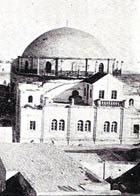The Messianic Aliyah

Today marks the rededication of the Hurva (literally, "ruin") Synagogue, once the jewel in the crown of the Jewish Quarter of the Old City of Jerusalem. Its history, and the debates over that history, open a window onto a fascinating chapter with powerful reverberations today.
In 1700, days after arriving from Poland, a Jewish pietist purchased an abandoned plot known since the 15th century as "the Ashkenazi courtyard," hoping to build a synagogue. When his followers proved unable to keep up their payments, the Arab creditors reduced the site to rubble. In the 19th century it arose again, magnificently, thanks to the efforts of a group known as Aliyat Talmidei Ha-GRA, "the aliyah of the disciples of the Gaon of Vilna."
The Gaon ("genius") Rabbi Eliyahu of Vilna (1720–1797) is celebrated for his massive erudition, intellectual independence, opposition to Hasidism, and elevation of ascetic study into a supreme religious ideal. No less consequential was his messianic teaching, grounded in the Kabbalah, that redemption could be hastened through natural human efforts, undertaken by a spiritual avant-garde in the Land of Israel. In 1808, a number of the Gaon's disciples emigrated, eventually settling in Jerusalem. Seeing in the "ruined synagogue" a potential nucleus for institution-building, they began negotiations with the Pasha for a permit. The synagogue was finally finished in 1864, a communal nerve center until its destruction by the Arab Legion in 1948.
As for the disciples' heirs and descendants, they split into two camps. Some, decades before Herzl, became active in building the new city of Jerusalem and in forming agricultural settlements. Others, taking their cue from the Gaon's spiritual elitism, preferred the cloister of the study hall and the pursuit of religious purity, creating a network of inward-looking institutions that became the forerunners of contemporary Haredi society.
The unearthing of this episode by the historian Arie Morgenstern and younger scholars has led to spirited rejoinders from those for whom Zionism represented a revolt against traditional religion, and could not have emerged from its very recesses. True enough, one cannot see in the Gaon's program anything like the mass social-political movement of classical Zionism. Yet it is undeniable that this small and unfamiliar group played a significant role in the modern Jewish return to the Land of Israel, and their story usefully complicates and deepens contemporary understandings of that return.
Comments are closed for this article.




